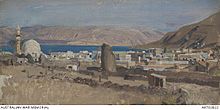| Capture of Tiberias | |||||||
|---|---|---|---|---|---|---|---|
| Part of the Middle Eastern theatre of World War I | |||||||
 "Tiberias" by George Lambert | |||||||
| |||||||
| Belligerents | |||||||
|
| |||||||
| Commanders and leaders | |||||||
|
| Unknown | ||||||
| Units involved | |||||||
|
Australian Mounted Division 3rd Light Horse Brigade 4th Light Horse Brigade | Yildirim Army Group's Tiberias garrison | ||||||
| Casualties and losses | |||||||
| Unknown | 100 prisoners | ||||||
The Capture of Tiberias took place on 25 September 1918 during the Battle of Sharon which together with the Battle of Nablus formed the set piece Battle of Megiddo fought between 19 and 25 September in the last months of the Sinai and Palestine Campaign of the First World War. During the cavalry phase of the Battle of Sharon the Desert Mounted Corps occupied the Esdraelon Plain (also known as the Jezreel Valley and the plain of Armageddon) 40–50 miles (64–80 km) behind the front line in the Judean Hills. One squadron from each of the 3rd and 4th Light Horse Brigades Australian Mounted Division attacked and captured Tiberias (on the western shore of the Sea of Galilee also known as Lake Tiberias), along with the Yildirim Army Group's Ottoman and German garrison.
The Tiberias garrison formed part of a rearguard stretching to Samakh and on to Deraa which was intended to cover the retreat of three Ottoman armies. They were set up to delay the advance of the Desert Mounted Corps of the Egyptian Expeditionary Force (EEF) after the British Empire infantry victories at the Battle of Tulkarm, Battle of Tabsor during the Battle of Sharon. These and other battles fought during the Battle of Nablus including the Third Transjordan attack, also part of the Battle of Megiddo, forced the retreat of the Ottoman Fourth, Seventh and Eighth Armies north towards Damascus.
Tiberias was captured by two squadrons of light horse, one from the 3rd Light Horse Brigade supported by armoured cars, and one from the 4th Light Horse Brigade after fighting the Battle of Samakh. The two squadrons converged on the town from the north–west and south respectively and took 100 prisoners. The remainder of the garrison retreated northwards to form a rearguard at Lake Hule with the survivors from the Samakh garrison. The next day the Australian Mounted Division and the 5th Cavalry Division pursued the Ottoman forces towards Damascus, paralleling the pursuit on the inland route begun by the 4th Cavalry Division a day earlier.
